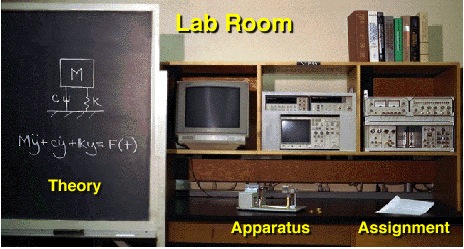Vibrating Beam Experiment
Engineering Courseware for a Senior Mechanical Engineering Lab at UC Berkeley
The Vibrating Beam Experiment Instructional Courseware was developed at the University of California, Berkeley to assist students’ integration of seemingly disparate information related to the experiment into a cohesive structure. The courseware provided a framework to understand the fundamental principles of the apparatus, theory, and laboratory procedures related to the experiment.
By using hypertext and hypermedia in the courseware, we provided multiple levels of material, including information that has not traditionally been available for this experiment (e.g., full derivations and supplementary reference material). The courseware had graphical maps that served as both a foundation for the structure as well as the backbone of the navigation. In user surveys, students responded that the courseware contributed to both their understanding of the preparatory homework as well as the laboratory itself. The on-line usage logs showed that the majority of navigation was linear despite the numerous alternate navigation schemes. Additionally, students were more interested in practical tips than the supplementary material that we included to help them understand the theory.
The usage logs also indicated student use of the courseware was very dependent on the instructor’s integration of the courseware into his / her teaching. The courseware was designed to be used in many different ways depending on the instructor’s preference. It contained the information required to let it serve as a stand-alone reference source for the theory involved in the experiment, or it could serve as a guide for the practical information required to complete the experiment.
I designed and developed the Vibrating Beam Experiment courseware. My Master of Science in Mechanical Engineering from the University of California, Berkeley was based on the courseware and research I conducted with it.
Info
University of California, Berkeley
Department of Mechanical Engineering
1993-1995
Key Collaborators: Pamela A. Eibeck* (UC Berkeley), Winston Wang (UC Berkeley), David Karp (UC Berkeley)
Funding Source: National Science Foundation

